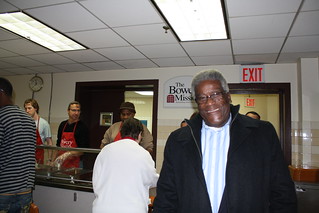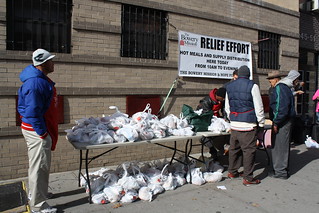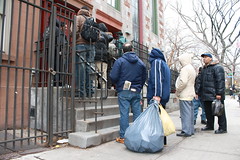Before restaurants and food distribution centers mobilized in the wake of Sandy, shelters and religious institutions that have long fed the neighborhood’s needy were already in high gear.
Last week, more than 160 additional people bunkered down in the Bowery Mission’s emergency shelter areas. James Macklin, director of outreach, said the shelter’s 10 staffers took the uptick in stride, continuing to serve three hot meals a day to 80 permanent residents as well as the influx of visitors.
“I was cooking by torchlight,” said Delon Ali, a chef at Bowery Mission. “We served 700 to 1,000 plates per day here.”
Aside from its long-term residents, the 133-year-old organization provides emergency housing for overnight guests when the temperature drops below 40 degrees and during extreme weather. During cold nights, the Mission might see up to 100 people sleeping in its chapel and dining room.
Mr. Macklin said 160 might have been a record high, but in the 27 years he has worked at the shelter, he has never seen anyone turned away. “I haven’t seen it done and I don’t think we will ever do that,” he said.
During the storm last Monday, the Mission, along with much of downtown Manhattan, was plunged into darkness. It took to Twitter to call for a generator. The next day, three came: two were used to power the Mission on Bowery and one was used at its Transitional Center on Avenue D.
The Mission gets regular donations from individuals and businesses including Whole Foods, Trader Joe’s, Duane Reade, and others. After the storm, there was an even greater outpouring of support. “We have buses coming all the way from Elmira, N.Y., loaded from top to bottom and they’re coming back again to help us do what we do,” Mr. Macklin said. Even neighboring pizzeria Pulino’s sent over some grub.
The donations weren’t just for those at the shelter. The Mission also distributes food all over the city, from churches to Coney Island. It gave away hot meals and supplies on Avenue D today.
Charles Reaves, 43, who had been staying at the Mission for five months, wasn’t troubled much by the storm. “It got a little crowded in here at night but it was okay,” he said. “It was for a good reason. We got to provide food and shelter for a lot of people who otherwise had nowhere to go.”
For Matt Krivich, 38, the Mission’s director of operations, Sandy brought a sense of uncertainty but also of unity. “It brought all of us together a little bit more because we didn’t have distractions. We have a great staff and our residents all stepped up and helped maintain order and keep people safe.”
Over at the Catholic Worker, workers were able to continue using gas ovens to serve hot meals to over 40 residents split between St. Joseph house and Maryhouse. The weekday soup line – normally open to the public from 10 a.m. till 11.30 a.m., Monday through Friday – continued uninterrupted. “But we were cooking in the dark,” said Carmen Trotta, 47, a Catholic worker.
The Catholic Worker did not house any Sandy refugees, since its houses are usually at capacity.
With their overstocked freezer, the workers were able to keep food cold for a few days after the power went out, before doing a cook-off with leftover meat. Some salad had to be thrown out but there was no big loss, according to Mr. Trotta.
“It was a humbling experience to see how quickly our high-tech society can crumble,” said Mr. Trotta. With the lights out, the residents were forced to sleep longer. And with nowhere to go, the workers and residents drew closer together as a community.
While the Catholic Worker’s soup line was a little longer than usual, Graffiti Church had a different experience. The church’s normal Wednesday and Saturday meal services saw fewer people than usual, probably because many had moved out of the area to seek shelter.
In addition to organizing a clothing drive, the church has been helping local residents clean out their apartments and fight mold. “People in this area have never had to deal with this problem before,” said Reverend Taylor Field. To address it, the church, at 205 East Seventh Street, will hold a free mold prevention seminar tonight, from 7 p.m. to 8:30 p.m.







